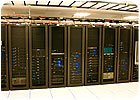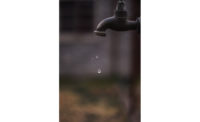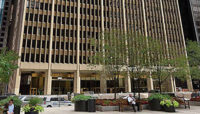
At Syska Hennessy Group, Inc., we are keenly aware that mission critical facilities are enormous consumers of electricity and water and can have a disproportionate impact on our environment and non-renewable resources. Some of these facilities include over 100,000 sq ft of technology space designed to operate at and sometimes beyond 200 W/sq ft. Such a facility will require 20 MW of electricity just to support the critical load, and when operated with current “best practices,” could require another 17 MW of critical infrastructure loads occupying another 100,000 sq ft of MEP space. As a result, you now have a single building, of approximately 200,000 sq ft, using 37 MW of energy 24/7/365. The federal government has called upon the EPA to initiate a study of the power consumption of these facilities by passing HR-5646 during the 109th Congress. The study will fall under the auspices of the EPA’s “Energy Star” program. That is only the energy side of the issue.
Let’s next consider the water consumption. These facilities typically employ large central cooling plants that include water cooled chillers and their associated cooling towers. The evaporation rate and associated makeup water requirements for these facilities can be very large. Makeup water requirements are influenced by regional weather variations, but for a “typical” site as described above, a maximum makeup rate could be as high as 150 gpm or more.
Investigating The Possibilities
To proactively address the energy consumption and environmental impact of these facilities, Syska created a specialized internal committee to investigate, research, and advise on cost-effective means of improving overall energy efficiency and reducing the environmental impact. Titled the Syska Green Critical Facilities Committee, its purpose is to take a holistic view encompassing the entire life cycle and total-cost-of-ownership perspective. The committee drafted a “Vision Statement and Strategic Plan” that defines the committee’s goals and objectives, specifically to “research and evaluate technologies, and recommend guidelines that promote energy efficiency and sustainability, without reducing reliability. We will consider all aspects of critical facilities, including requirement definitions, site and equipment selection, design, constructability, commissioning, operations and maintenance, and overall life cycle costs.” One of the key points here is the philosophy that any and all concepts, technologies, recommendations, etc., must not reduce reliability. As costly and demanding as these facilities are, the mission or operations that they perform takes first priority, and availability, or uptime, is absolutely paramount and cannot be compromised.The committee also agreed to a core set of goals and objectives on which to focus its efforts. Among these are capitalizing on proven technology available today, while exploring developing technologies that hold promise in the near future. Another is avoiding a “one-size-fits-all” approach, instead recognizing that green solutions are directly affected by regional variations in weather, utility costs, and localized environmental considerations. An obvious example is the potential savings of incorporating waterside or airside economizers. The theoretical hours that these could be used would be directly affected by the outside air conditions, which vary from region to region. Energy cost savings are affected by the electric rate, which also varies greatly by region and location. One of the committee’s key messages is that “reliability and sustainability do not have to be at odds with each other” and that uptime can be delivered in better ways than traditional design. Many aspects of critical facilities lend themselves to sustainable design concepts, such as re-use of “grey” water and condensate recovery for cooling tower makeup. Other viable concepts may include incorporating wetland preservation into the physical security “setback” that many of these facilities require, or increasing the voltage of electrical distribution systems to reduce the amount of copper.
Critical facility infrastructures can be extremely complex, including complicated system interrelations and control sequences. These complex infrastructures require highly trained and knowledgeable operating staff to monitor and react to anomalies when required. Considering that over half of all unavailability incidents are associated with human activity (planned switching operations, testing, maintenance activities, and of course, human error), simplifying the infrastructure can increase reliability and save energy. Including formal, comprehensive commissioning into the entire process of designing, constructing, and operating these facilities can provide enormous benefits. True commissioning delivers not only efficient and reliable performance, but also ensures that the facility is thoroughly documented, with formal written O&M procedures, and a well-trained staff armed with site specific knowledge on day one.

HVAC Issues
Syska’s Green Critical Facilities Committee is reviewing various HVAC system design options to significantly reduce the cost of operating a 24/7 critical facility. These design options challenge traditionally accepted best practices for critical facilities, yet they are commonplace in large high-performance commercial buildings. Improved equipment design and control strategies have changed the HVAC industry over the last 10 years. The main resistance to newer technology is the perceived risk that newer technology will reduce a facility’s overall reliability; however, consideration should still be given to applying these newer technologies to critical facility designs. At 10 years of age or more, these technologies are no longer “new” or “unproven.”The fact of the matter is that data center owners can optimize cooling with alternative HVAC design. Most traditional data centers use recirculating computer room air conditioning (CRAC) units and raised floors to provide cooling. Though effective, in many instances, there are more efficient alternative solutions with many other benefits as well. Built-up central AHU designs can offer added reliability and energy savings by providing free cooling, and VFDs on fan motors for VAV distribution.
The equivalent AHU solution, compared with a traditional CRAC design, will employ fewer, larger units that provide improved energy efficiency, decreased maintenance activities, improved accessibility, and simpler control schemes. Such designs can improve system availability and reliability over traditional designs while employing well-understood, proven technology and equipment.
Additionally, many data centers can improve heat dissipation in IT equipment by employing overhead cooling. This option should be evaluated using computational fluid dynamics (CFD) modeling.
Most traditional data center designs rely on large central chiller plants to provide chilled water to the air distribution units. Chiller plant optimization is key to achieving significant energy savings on mechanical cooling. Piping, pump, and chiller selection and configuration have a tremendous impact on performance, including energy efficiency.
The coefficient of efficiency (COE) for data centers, defined as the ratio of energy into a facility (i.e., utility main) to the energy out to the critical equipment (i.e., UPS output) during design conditions, can average between 2 and 3 in many of today’s older facilities. Some of the newer, more efficient facilities register at around 1.7. While some of this inefficiency relates to transformer losses, UPS losses, and other transport losses, a major portion of these inefficiencies relates to the mechanical equipment. There is little doubt that if some of the accepted industry practices for high-performance commercial buildings are applied to the design of critical facilities, considerable improvements could be made in the COE.
Some savvy data center owners understand that implementing newer, more efficient designs will positively affect the business’ bottom line while concurrently improving the “greening” of their corporate culture. Yet, most facility managers would never attempt to reduce operating cost if there were any perceptible accompanying risk of reduced reliability. Some industry experts are now convinced that the COE can be reduced to 1.5 if highly efficient designs are implemented. When considering the COE as a ratio representing annualized energy usage (kWh consumed by equipment, which includes the use of energy-efficient options such as economizers and other non-standard designs), they push for a COE of as low as 1.25. The challenge is passed on to the design engineer: Produce a more efficient, sustainable design that in no way reduces the facility’s reliability.
Owners create the motivation through necessity, and the design engineers must find creative ways of getting the desired results. The irony of this whole process is that data center designers are now being asked to think out of the box and then the resulting ideas are compared and measured against traditional paradigms. The resulting designs are not necessarily technically innovative, but innovative only in the sense that they haven’t been applied to standard data center designs before.

Traditional vs. Green HVAC
What standard data center HVAC design concepts must be challenged in the pursuit of a sustainable design approach? And what are the green alternatives? The following are a few of the standard HVAC design approaches that the Syska Green Critical Facilities Committee is now considering for new project designs.CRACs vs. built-up AHUs. In the early days of data center design, CRAC units were invented to provide modular, scalable, closely controlled environments for the mainframe computers that were housed within these spaces. These mainframe computers required fixed temperature and humidity control to within very close tolerances; as a result, the term “precision cooling” was created. Today’s data centers don’t require such close tolerances - in fact, ASHRAE’s “Thermal Guidelines for Data Processing Environments” recommends 68°F to 77° and 40% to 55% rh at the inlet to the servers or computer devices. The “allowable” range is even broader. Note that these conditions are required only at theinletair location for the IT hardware (or the cold aisle in hot/cold aisle configurations). With few exceptions, nowhere else in the space is there any requirement for temperature and humidity. Yet, the industry continues to push the concept of precision cooling.
But how precise is precision cooling? Looking at conventional CRAC units, they are basically no different from any AHU - they contain a fan, a coil, and a robust controller to maintain the required environmental condition. Sometimes, a humidifier and/or a reheat coil are added, but the same can be done for any AHU.
As part of the sustainable approach, the design engineer must remain open-minded in the selection of the air movers for a data space. This includes using large customized AHUs that are located off the data center floor in fan galleries, mezzanines, or even on the roof. Using large customized AHUs opens the possibilities of achieving higher fan efficiencies and reducing central plant operation by utilizing outside air economizers. By reducing the overall number of cooling units, it is actually easier to provide a more stable cold aisle environment through the use of centralized controls (as opposed to unitary controls commonly used for conventional CRAC units), the risk of units fighting each other for control of space temperature or humidity is reduced. Moving the units outside of the raised floor environment also eliminates routing water piping near the IT equipment, eliminates potential fire and smoke hazards from the HVAC and associated electric supplies from the raised floor, and improves maintenance access, all of which improve reliability. The simplified control sequences reduce human error and costs.
Primary-secondary chilled water piping vs. variable primary flow chilled water piping. Primary-secondary pumping schemes have been used for the entire lifetime of most of today’s HVAC engineers. They’re reliable and very easy to operate. Engineers typically find this arrangement easy to design and understand. The secondary chilled water loop typically uses a VSD to reduce pump flow to meet the facility’s instantaneous load, so there is obviously an energy-efficient component to this design over the preceding fixed-flow, primary-only concept. Yet, with recent advances in chiller design, variable primary flow through chillers has become common and manageable.
Given that data center loads are very stable, the risk of reducing flow through a single chiller to a quantity that puts a chiller or an entire facility at risk is negligible. The upside is that the installed costs of variable primary-only schemes are usually less than conventional primary-secondary systems, again through less equipment and simpler control schemes. Additionally, the operating costs, especially at part load, are significantly better.
Parallel vs. series chiller configurations. Astute engineers should consider designing the central chiller plant to operate multiple chillers in series as opposed to the traditional parallel approach. By operating two chillers in series with a combined increase in overall chilled water temperature ΔT of 16°, each chiller will operate at higher efficiency than a similar capacity design with two chillers in parallel with the standard 10° ΔT. By operating the chilled water system at a greater temperature differential, the same amount of cooling capacity can be delivered using smaller pipes and pumps, due to reduced flow. This results in additional energy savings with reduced pump horsepower and improves the energy efficiency of the air distribution units (CRACs or AHUs) as well.
Underfloor air distribution vs. overhead ducted air distribution. The language we normally use to describe a data center space already implies a certain air distribution design. Many engineers, facility managers, and owners, in speaking of a data space that doesn’t yet exist, say “I want my raised floor space to be …”. The space hasn’t been designed yet, but it is already assumed to be a “raised floor” space.
Sevearl studies have shown that under certain conditions, overhead air distribution can cool more effectively than underfloor air distribution while using less airflow. Again, we see the potential for better performance with reduced energy consumption. A resultant benefit is that the entire infrastructure is easily visible and physically separated from the IT working space (vs. buried below a raised floor and subjected to possible damage from both IT and facilities staff working in the difficult access in congested spaces that are common below raised floors). This can again result in improved system availability and reliability.
Many designers are uncomfortable at the prospect of not using a raised floor. To help make the paradigm shift, they need only visit their local neighborhood telecom central office. The telecommunications industry has been using overhead, non-raised floor environments for decades. The net result of the fan energy reduction associated with the reduced airflow goes toward achieving the more favorable COEs. Eliminating the raised floor can also simplify the design and reduce the installed cost of the fire detection and suppression systems. Although this design concept should be considered for new projects, it is generally not feasible for retrofitting to existing facilities, especially if the facility is required to continue operations during the renovation.
Water Consumption and Conservation
Critical facilities typically consume large amounts of water. Cooling tower drift and blow-down are the biggest water wasters. Specifying drift eliminators and filtration systems can significantly reduce drift and blow down. Evaporation in open towers that are not in service is difficult to avoid. In cooler climates (e.g., Denver), closed fluid coolers should be considered as an alternative to evaporative towers.Frequent testing of the condenser water quality, and heightened attention to the water treatment systems, can have dual benefits by reducing water consumption (reduced blowdown equals reduced makeup) and reducing the amount of water treatment chemicals required.
Also, the relatively large building “footprint” compared to the generally small staffing can present design opportunities for rain water harvesting and grey water re-use (including condensate recovery).

The Syska Green Critical Facilities Committee
Our Green Critical Facilities Committee intentionally includes membership representation from a wide swath of expertise, qualifications, experience, and backgrounds. The committee includes LEED®-accredited professionals, professional engineers (mechanical and electrical), a certified plant engineer, a member of the USGBC, an energy modeling specialist, expertise in CFD modeling and other predictive technologies, and a building automation, monitoring, and controls specialist.The membership also includes representation from diverse geographic areas including Los Angeles, Chicago, New York, Atlanta, and Charlotte. The belief is that sustainability is best done in teams (both internally and externally). The committee promotes the early involvement in green critical facilites (CF) projects of all stakeholders including owners, developers, local AHJs, vendors, and consultants.
Also critical to the team’s success is the visible support it has from Syska’s top executive management, exemplified by including on the committee the senior vice president of the firm’s CF division, two VPs, and the CF chief engineer. The committee has its own operating budget, direct access to the firm’s various Technical Leadership Committees, and is represented on the firm’s “Green Team.” Processes are in place for the committee to solicit help from and disseminate information to the entire firm via technical contacts strategically placed throughout the firm’s many offices and locations.
So far the committee recommendations have been very well received by many of the firm’s largest clients. Project teams have solicited site-specific recommendations and suggestions from the Green CF Committee in response to interest from the clients for non-traditional, green approaches to designing new and existing facilities. For each project, the project team provides site-specific background and technical requirement details to the committee and then schedules a formal brainstorming session.
The resulting site-specific recommendations include various concepts and alternatives presented to the client for consideration. This may be followed up with more detailed cost analysis and engineering studies to refine and justify, including the concepts in the project programming and basis-of-design documents. In some cases, the clients are interested not only in the cost implications, but also in how they can use these concepts to improve their green reputation and claim environmental stewardship in their corporate branding.ES
For more information or to contact the Syska Green CF Committee, visit the Syska website at www.syska.com and proceed to the Critical Facilities page, or contact committee member Carol Walker at 310-254-3980 or by e-mail at cwalker@syska.com.







